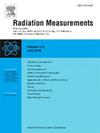A method for reducing gamma-ray coded-aperture imaging artifacts based on Compton sequence reconstruction
IF 2.2
3区 物理与天体物理
Q2 NUCLEAR SCIENCE & TECHNOLOGY
引用次数: 0
Abstract
Gamma-ray coded-aperture imaging technology has important applications in nuclear safety monitoring, the decommissioning of nuclear facilities, and the transportation of spent fuel. However, the Compton scattering effect occurs when gamma rays interact with the detector, leading to a large number of random artifacts in the reconstructed images. These artifacts degrade the quality of coded-aperture imaging. In this paper, a coded-aperture imaging method based on Compton sequence reconstruction was proposed to reduce artifacts in image reconstruction. Additionally, the energy discrimination method suitable for Compton two-event sequence reconstruction was improved, and a probability method was proposed for Compton multi-event sequence reconstruction. Through simulations, the improved energy discrimination method was validated for its enhancement in the accuracy rate of sequence reconstruction. The probability method was compared with the conventional minimum squared difference (MSD) and deterministic methods, confirming that the probability method achieved the best sequence reconstruction results and accurately identified the full-energy event. In single-source and multi-source imaging experiments, the proposed image reconstruction method was compared with the conventional maximum likelihood expectation maximization (MLEM) algorithm and the mask and anti-mask coded functions (MACF) algorithm. The results demonstrated that the probability method combined with the MACF algorithm effectively reduced random artifacts and thickness artifacts in the reconstructed images, significantly improving imaging quality.
基于康普顿序列重构的伽马射线编码孔径成像伪影减小方法
伽玛射线编码孔径成像技术在核安全监测、核设施退役、乏燃料运输等方面有着重要的应用。然而,当伽马射线与探测器相互作用时,会发生康普顿散射效应,导致重建图像中出现大量随机伪影。这些伪影降低了编码孔径成像的质量。本文提出了一种基于康普顿序列重构的编码孔径成像方法,以减少图像重构中的伪影。此外,改进了适用于康普顿双事件序列重构的能量判别方法,提出了适用于康普顿多事件序列重构的概率方法。通过仿真,验证了改进的能量识别方法在序列重建准确率上的提高。将概率方法与传统的最小平方差(MSD)和确定性方法进行了比较,结果表明,概率方法获得了最好的序列重建结果,并能准确地识别出全能量事件。在单源和多源成像实验中,将所提出的图像重建方法与传统的最大似然期望最大化(MLEM)算法以及掩码和反掩码编码函数(MACF)算法进行了比较。结果表明,概率方法与MACF算法相结合,有效地减少了重构图像中的随机伪影和厚度伪影,显著提高了成像质量。
本文章由计算机程序翻译,如有差异,请以英文原文为准。
求助全文
约1分钟内获得全文
求助全文
来源期刊

Radiation Measurements
工程技术-核科学技术
CiteScore
4.10
自引率
20.00%
发文量
116
审稿时长
48 days
期刊介绍:
The journal seeks to publish papers that present advances in the following areas: spontaneous and stimulated luminescence (including scintillating materials, thermoluminescence, and optically stimulated luminescence); electron spin resonance of natural and synthetic materials; the physics, design and performance of radiation measurements (including computational modelling such as electronic transport simulations); the novel basic aspects of radiation measurement in medical physics. Studies of energy-transfer phenomena, track physics and microdosimetry are also of interest to the journal.
Applications relevant to the journal, particularly where they present novel detection techniques, novel analytical approaches or novel materials, include: personal dosimetry (including dosimetric quantities, active/electronic and passive monitoring techniques for photon, neutron and charged-particle exposures); environmental dosimetry (including methodological advances and predictive models related to radon, but generally excluding local survey results of radon where the main aim is to establish the radiation risk to populations); cosmic and high-energy radiation measurements (including dosimetry, space radiation effects, and single event upsets); dosimetry-based archaeological and Quaternary dating; dosimetry-based approaches to thermochronometry; accident and retrospective dosimetry (including activation detectors), and dosimetry and measurements related to medical applications.
 求助内容:
求助内容: 应助结果提醒方式:
应助结果提醒方式:


